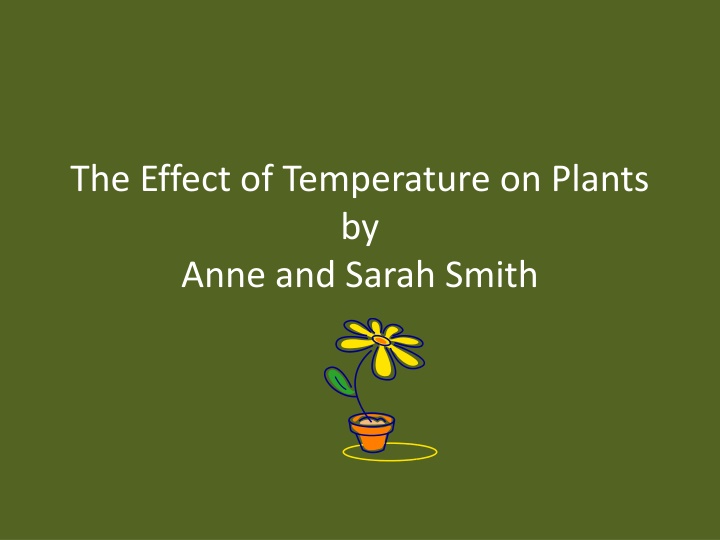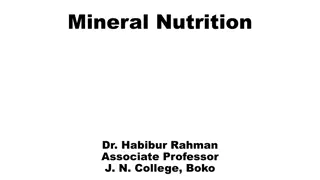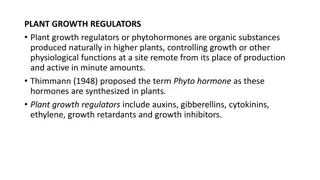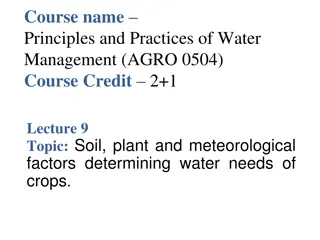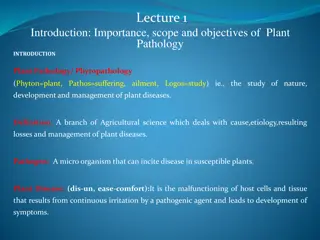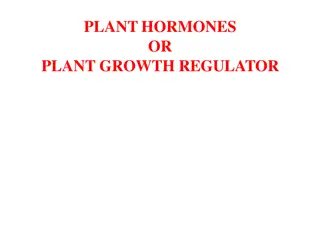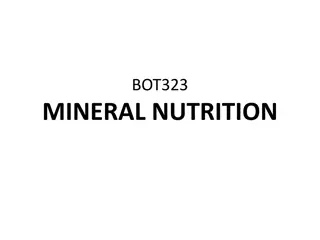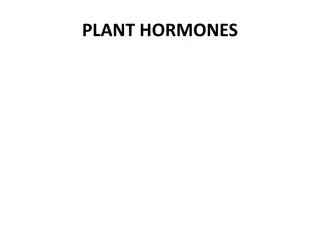Study on the Effects of Temperature on Plant Growth
This project, conducted by Anne and Sarah Smith, investigated the impact of temperature on plant growth using radish plants. The results supported the hypothesis that plants grow more successfully in warm temperatures compared to extreme temperatures. Prior research highlighted the importance of mild, moist, and warm conditions for plant growth. The experiment involved monitoring radish plants exposed to different temperature settings over a two-week period. By measuring plant growth and observing their responses, the study shed light on how temperature influences plant development.
Download Presentation

Please find below an Image/Link to download the presentation.
The content on the website is provided AS IS for your information and personal use only. It may not be sold, licensed, or shared on other websites without obtaining consent from the author.If you encounter any issues during the download, it is possible that the publisher has removed the file from their server.
You are allowed to download the files provided on this website for personal or commercial use, subject to the condition that they are used lawfully. All files are the property of their respective owners.
The content on the website is provided AS IS for your information and personal use only. It may not be sold, licensed, or shared on other websites without obtaining consent from the author.
E N D
Presentation Transcript
The Effect of Temperature on Plants by Anne and Sarah Smith
Abstract The purpose of this project was to discover how plants react to temperature. The hypothesis was if a plant is exposed to warm temperatures (15 to 21 degrees Celsius) they will grow faster than plants exposed to hot temperatures (32 to 38 degrees Celsius) or cold temperatures (4 to 10 degrees Celcius) because most plants grow in warm and mild climates versus extreme climates. The results collected during this experiment showed that plants grow more successfully in warm temperatures versus extreme temperatures. The hypothesis was supported; the plants in the 15 degree environment grew the tallest. Future experiments could test different types of plants in various temperatures or changes in moisture.
Prior Research Research shows that green leafy plants grow more successfully in mild, moist, and warm temperatures. The type of plant should also be taken into consideration. There are plants that are more successful in hot temperatures versus cold temperatures. Some plants are able to adapt to their environment over time. Germination of seeds need warm, moist environments and then once the seed has sprouted a warm and partial sunny location is best for the plant s stability. (Carolina Biological Society, 2001)
Purpose/Question What is the effect of temperature on plants?
Hypothesis Plants that are exposed to warm and mild temperatures like 60 F (15 C) to 70 F (21 C) degrees will grow more successfully than plants exposed to more extreme temperatures because extreme temperatures can cause stress on the leaves and roots of the plant.
Materials 5 radish plants Thermometer
Experiment/Procedure 1. Five radish plants were planted and placed in a refrigerator at a temperature of 5 Celcius. Another five radish plants with the exact same variables were placed in a warm room at 15 Celcius. Another five radish plants with the exact same variables were placed in a very hot container with a heat lamp at 38 Celcius. All plants were under a lamp with a 60 watt bulb. All plants received 2 ounces (57 grams) of water every other day. All plants were in the same size pot with the same soil. Plants were monitored for 2 weeks and measured every 2 days. Measurements were recorded and pictures were taken every other day. 2. 3. 4. 5. 6. 7. 8.
Data Collection Table Centimeters tall: average of all 5 plants Day 5 degrees C 15 degrees C 38 degrees C 1 0 0 0 3 0 0 0 5 0 .5 cm 0 7 .3 cm 1 cm .2 cm 9 1 cm 1.2 cm .2 cm 11 1 cm 2 cm .5 cm 13 1.5 cm 2.5 cm .5 cm 15 1.5 cm 3 cm .5 cm Average .66 cm 1.75 cm .22 cm
How much the plants grew in 15 days 3.5 3 2.5 2 c m 5 c 1.5 15 c 1 38 c 0.5 0
Analysis/Discussion of Results Two of the plants in the refrigerator died after one week. The other three plants only grew an average .66 cm. The plants in the warm environment were most successful although one of the plants died, the other four grew an average of 1.75 cm. Three plants died in the hot environment and two of the plants grew an average of .22 cm. The plants in the warm environment looked healthier and their leaves looked very green and the stems were straight. The plants in the hot environment wilted and the stems were leaning over. The plants in the cold environment looked brown and unhealthy.
Conclusion The hypothesis was supported. The plants in the warm environment were more successful and grew the most compared to the others. This was supported by the research. Radish plants were used as they grow very rapidly under the right conditions.
Future Research This experiment could be repeated with different types of plants with different temperatures. For example several samples of vegetables could be used or several samples of flowers could be used to see if the results were the same.
References Carolina Biological Institute (website, 2012) Plants and how they Grow (book: NYC Publishing) Video: How to successfully grow radishes (youtube, discovery channel)
